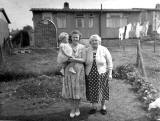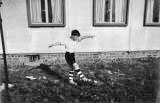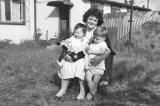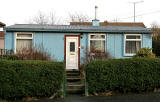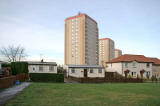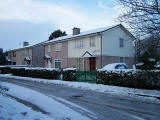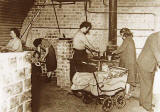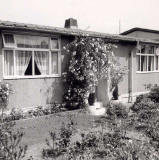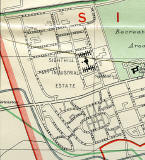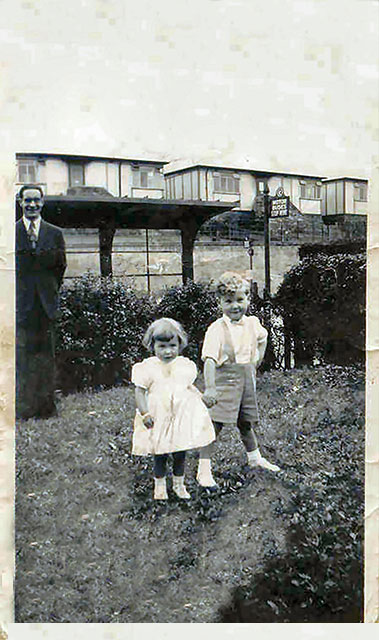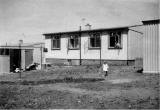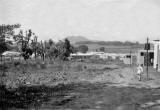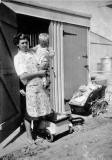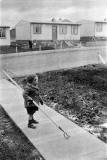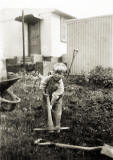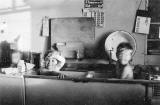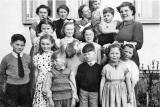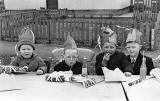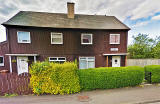|
Prefab Housing Late-1940s / Early-1950s |
|
Please scroll down this page, or click on one of these links: A. Background B. Exhibition |
|
A. Prefab Housing Late-1940s / Early-1950s Background |
||||||||||||||||||||||||||||||||||||||||||
|
Recollections Several other pages in the 'Recollections' section of the EdinPhoto web site include memories and photos of prefab housing in Edinburgh. See: Gilmerton - c.1950 |
||||||||||||||||||||||||||||||||||||||||||
|
Britain In order to meet the housing shortage as World War II was coming to an end, Wilson Churchill announced a Temporary Housing Programme in 1944. The program planned to build 500,000 prefab bungalows in Britain over the next four years. They were expected to last for fifteen years. In fact just over 150,000 were built, including about 4,000 in Edinburgh. |
||||||||||||||||||||||||||||||||||||||||||
|
Thank you to Neil Lawrence, Edinburgh for giving me the details of the Edinburgh prefabs below. I don't know how many, if any, have survived. There were four types of prefab in Edinburgh: - Aluminium 1792 - Arcon 757 - Seco 815 - Tarran 636
After the initial 4000 above were built, Edinburgh purchased an additional 166 Permanent Aluminium houses, 145 for Craigour and 21 for Muirhouse. Edinburgh Today A few of the 1940s prefab bungalows in Edinburgh have survived to today (January 2008). They still appear to be in good condition. Most have been modernised, but a few still retain many of their original features. In January 2008, I visited many of the areas in the table above. I found and photographed several prefab bungalows in the Moredun (Craigour) area: |
||||||||||||||||||||||||||||||||||||||||||
|
Acknowledgements (1) Thank you to Neil Lawrence, Fountainbridge, Edinburgh for providing the details above. Neil tells me: - The numbers of the individual types of prefabs were taken from Edinburgh Council Minutes. - The numbers built by each scheme have been worked out from various sources: City drainage records, old OS maps and more Edinburgh Council Minutes. There seems to be very little in the way of proper documented information on Prefabs in general. They were built under special war-time powers and didn’t require formal planning or building warrant permissions. (2) Thank you to Bob Henderson, Burdiehouse Edinburgh for telling me that there were still some prefab bungalows to be found around Moredun. I found some at: - Craigour Avenue - Craigour Crescent - Craigour Drive - Craigour Grove - Moredun Park - Moredun Park Court There may well be others that I have still to find. Peter Stubbs: Edinburgh |
|
B. Prefab Housing Late-1940s / Early-1950s Exhibition |
|
Treasured Places The exhibition, Treasured Places, was displayed at the City Art Centre from 25 October 2008 to 17 January 2009 to commemorate the centenary of RCAHMS (The Royal Commission on the Ancient and Historical Monuments of Scotland). The exhibition featured a wide variety of properties in Scotland, including an Edinburgh prefab, No 55 - possibly 55 Craigour Avenue. The exhibition explained that this was one of 32,000 prefabs erected in Scotland in the late 1940s. It had been supplied by AIROH (Architectural Industries Research Organisation on housing). Prefabs were detached and had large gardens. They were usually popular with their owners. Prefabs were constructed of aluminium because, following the end of World War II. Prefabs were partly assembled (prefabricated) in factories before being delivered to the site. In Scotland, 3,205 prefabs survived to 1971. Here is one of several in the Craigour and Moredun, Edinburgh that was still occupied and appeared to be in good condition in 2008: |
|
C. Prefab Housing Late-1940s / Early-1950s Recollections |
||
|
Alan Bass |
- Craigour Avenue |
|
| 1. |
Bob Henderson with reply from Neil
Lawrence |
- Burdiehouse - Greendykes |
| 2. |
Bryan Gourlay |
- Burdiehouse - Delivery - North Berwick and Biggar |
| 3. |
Douglas Beath with reply from Neil
Lawrence |
- Good Old Prefabs - Crewe Road and East Pilton |
| 4. |
Bob Henderson |
- Swedish Design |
| 5. |
Liz Black |
- Greendykes - Holyrood |
| 6. |
Betty Campbell |
- Craigour Drive - Countryside |
| 7. |
Liz Taylor (née
LAMB) |
- Craigour Road - Golf Balls |
|
Ron Ross |
- Hyvot Terrace, Gilmerton |
|
|
Carl Gorman |
- Golf Course |
|
|
Lilian Young |
- Calder Road |
|
|
Robert Black |
- Calder Drive |
|
|
Reply 1 |
Tom Pillans |
- Calder Drive |
|
Reply 2 |
G A Ford |
- Calder Drive |
|
Monica Pudel |
- Northfield Prefabs |
|
|
Moira Clarke |
- Calder Drive - Fields |
|
|
14. |
Jim Browning |
- Moredun Park Rise |
|
15. |
Terry Dolan |
- Found under the floor boards |
|
16. |
Rab Young |
- Calder Walk |
| 17 |
Pamela Thompson |
- Milton Drive |
| 18 |
Patricia Mcdonald |
- Milton Grove, Portobello |
| 19 |
Joann Arthur |
- Mountcastle Drive |
| 20 |
Patricia Mcdonald |
- Milton Grove,
Portobello - Tight Squeeze - Games - Good Old Days |
| 21 |
Pamela
Thompson |
- Milton Grove,
Portobello - Tight Squeeze |
| 22 |
Chris Smith |
- Calder Walk |
| 23 |
Annette Kelly (née Bruce) |
- Northfield Drive |
| 24 |
George Brodie |
- Northfield Grove |
| 25 |
Robert Laird |
- Prefabs at Redhall - Slateford & Longstone Public Hall - Prefabs and Bus Stop |
| 26 |
Andrew Morton |
- Craigour Avenue |
| 27 |
Andrew Morton |
- Craigour Avenue - Craigour Loan |
| 28 |
Lilian Young |
- Calder Road |
| 29 |
Roddy Hunter |
- Calder Crescent - My Home - My School |
| 30 |
Roddy Hunter |
- Calder Crescent - My Prefab Home - Move to Stenhouse - Move to Rochdale - Return Visits to Edinburgh |
| 31 |
Sonia Zhuravlyova |
- Swedish Prefabs |
| 32 |
Archie Young |
- Milton Drive and Coillesdene Avenue - The Prefab Houses - Photos - Buses - Leaving the Prefabs |
| 33 |
Stuart Lyon |
- Swedish Houses - West Pilton Place |
| 34 |
Ian Wood |
- Swedish Prefabs |
| 35 |
Ian MacKay |
- 60 Northfield Drive - Our Prefab - Our Family - Our Neighbours |
|
Recollections 0. Alan Bass Craigour, Edinburgh |
|
Thank you to Alan Bass for contacting me when he recognised a picture of the prefab that he used to live in at Craigour. Please click on the thumbnail image below to read Alan's comments: Craigour Avenue Acknowledgement: Alan Bass, Craigour, Edinburgh: August 2+6, 2009 |
|
Recollections 1. Bob Henderson Burdiehouse, Edinburgh |
||
|
Referring to the comments above, Bob Henderson, Burdiehouse sent me the photo below. Please click on the photo to enlarge it. Bob wrote: |
||
|
Burdiehouse "Here's another type of prefab. This photo shows the houses in their old and metamorphosed state. These are BISF houses and were made in huge numbers all over the UK. I have lived in one of these in Burdiehouse for the last 35 years. The conversion has turned them into very snug and fuel efficient homes."
|
||
|
Greendykes "I also lived for a short time in one of the other type, an asbestos one in Greendykes. It was a great wee hoose. Imagine going from a single-end with no hot water and an outside shared lav. to your own wee bungalow with hot and cold running water and a bath with, wonder of wonders, a gas- operated fridge built in to the fitted kitchen!" |
||
|
Bob Henderson, Burdiehouse, Edinburgh: January 4, 2007 |
|
Recollections 2. Bryan Gourlay Biggar, Lanarkshire, Scotland |
|
After reading the comments above, Brian Gourlay wrote: |
|
Burdiehouse "It’s been interesting reading Bob Henderson’s recollections and experiences of living in pre-fabs. I never knew they made the two level version in Bob’s photo. My grandmother moved to one in Burdiehouse Loan in 1947 and lived there for years, but I never realised it was a pre-fab. Her daughter has lived in Burdiehouse Avenue for 50 years, now in one of the upgraded ones in Bob’s photo." |
|
Delivery "In the late 1940s, I can remember seeing pre-fab houses being delivered, going down Dalkeith Road on the back of low-loader lorries, as I walked to school. They were like small bungalows sliced in half with sinks, bathrooms and lots of other things already fitted. |
|
North Berwick and Biggar "Pre-fab houses were also to be found in North Berwick, up near the Law, where they were demolished around 1970. There is a nice prefab development still alive and kicking close to the high school and opposite the golf course in Biggar. |
|
Bryan Gourlay, Biggar, Lanarkshire, Scotland: January 23, 2008 |
|
Recollections 3. Douglas Beath Tasmania, Australia |
|
|
Douglas Beath added: |
|
|
Good Old Prefabs! "Good old prefabs! History should accord them a round of applause. The postwar radio comedy 'Stand Easy!' with Cheerful Charlie Chester's gang included a weekly current affairs skit as a chant accompanied by tomtoms. One was
'Down
in the jungle, |
|
|
Crewe Road and East Pilton "I remember the bungalows between Crewe Road North and Crewe Road West. Also, just south of there around Crewe Road Gardens and overlooking the partly-filled railway cutting to East Pilton, there were several Swedish-supplied two-storey prefabs, presumably the type Bryan Gourlay was unaware of because they were not immediately recognizable as prefabs."
|
|
|
Douglas Beath, Tasmania, Australia: January 25, 2007 |
|
Recollections 4. Bob Henderson Burdiehouse, Edinburgh |
|
Bob Henderson added: |
|
Swedish Design "Douglas Beath mentioned the Swedish version of the prefab houses. These were different again, being built entirely from wood. They were years ahead of their time, as far as UK regulations were concerned. I believe they only got past these regs. because of the war, and very few other timber houses were built for many years after them. Nowadays, of course, we have taken account of the millions of timber houses in the States, Canada, Scandinavia etc. and come to recognise that they do not pose any more risk in case of fire than other types of construction. |
|
Bob Henderson, Burdiehouse, Edinburgh: July 13, 2008 |
|
Recollections 5. Liz Black California, USA |
|
Thank you to Liz Black for adding her comments to the EdinPhoto guestbook. Liz wrote: |
|
Greendykes "I was born in Edinburgh. I lived on South Clark Street, then Greendykes Avenue in the prefabs. Holyrood My grandparents lived on Holyrood Road in a tenement held up with wood supports, across from a teachers' college. |
|
Bob Henderson, Burdiehouse, Edinburgh: July 8, 2008 |
|
Recollections 6. Betty Campbell Northfield, Edinburgh |
|
Here is a view looking to the NW down Craigour Drive, with just one prefab remaining in this photo. It's the low bungalow, No 70, Craigour Drive. When these houses were erected in the mid-1940s, they had an expected lifetime of about fifteen years, but a few were still standing, and looking good, in the Craigour district of Edinburgh, close to the new Edinburgh Royal Infirmary when I photographed them in January 2008. Peter Stubbs: July 23, 2008 |
|
Betty Campbell lived with her family for nearly five years at Duddingston Camp in the 1940s before moving to a prefab at Craigour. |
|
Betty wrote: Countryside "We lived in 76 Craigour Drive. I loved it there as it was still countryside at that time. There was a farm behind us where the cows came right up to the fence at the back of our home. The farmer had a pony named 'Trigger' who all us kids loved. When he saw us around, he would come to us for treats etc." Betty Campbell, Northfield, Edinburgh: July 23, 2008 |
|
Recollections 7. Liz Taylor (née Lamb) Edinburgh |
|
Thank you to Liz Taylor (née Lamb) who wrote: |
|
Craigour Road "I used to live in a prefab in Craigour Road. Ours was at the end, overlooking Liberton Golf Course (the fourth tee?). As the ground dipped down towards the burn there, our prefab was built up on bricks to make it level with the others in the row! We had about 15 steps up to both doors!" Golf Balls "We also used to get loads of golf balls in our garden. According to my sisters, I used to hunt them, collect them in an old paint tin and give them to the Greenkeeper (Mr Gemmell) and he used to give me half a crown for a full tin!" Liz Taylor (née Lamb), Edinburgh: July 31, 2008 |
|
Recollections 8. Ron Ross Edinburgh |
|
Thank you to Ron Ross for sending this photograph of the prefab house at Hyvot Terrace where he lived with his family from 1949 until 1958. |
|
Ron wrote "I lived in a prefab at 4 Hyvot Terrace from 1949 until 1958. This photo of the house was taken in 1961, about a year before the prefabs were all demolished." 4 Hyvot Terrace Ron Ross, Brompton, Ontario, Canada: February 3, 2009 |
|
Please click on the thumbnail image above to enlarge the photo and read more about it. |
|
Recollections 9. Carl Gorman Port Elizabeth South Africa |
|
Thank you to Carl Gormon who read Liz Taylor's comments about the golf course (7 above) and replied. |
|
Carl wrote "The Late Mr Gemmell referred to in section 7 above is my late Grandfather. My Mom, Isobel (Gemmell) grew up on the golf course. Carl Gormon, Port Elizabeth, South Africa: May 14, 2009 |
|
Please click on the thumbnail image above to enlarge the photo and read more about it. |
|
Recollections 10. Lilian Young Hamilton Square, New Jersey, USA |
|
Thank you to Lilian Young who wrote: |
|
Calder Road "I was born in Edinburgh, and lived in a flat in Jamaica Street, then moved to Viewforth Square, Saughton Loan, Calder Road and Whitson Walk before coming to the US. My Mom, brother and I were amongst the first people to live in prefabs on Calder Road. We lived at No 547. Mom loved the many built-in closets, cabinets and drawers and swore it must have been designed by a female since males would never have thought of this feature." Demolition "It's a shame that the prefabs were pulled down. I went to Calder Road when I came home in 2006, but couldn't locate where this house had stood. Of course, I was saddened to see the number of beautiful old, historical buildings which had been replaced by the awful steel and glass monstrosities. We see enough of this type of building here, and I just wish the historical buildings I recalled from my youth had still been standing." Lilian Young, Hamilton Square, New Jersey, USA: August 13, 2009 |
|
Old Buildings Despite their planned lifetime of fifteen years, some of Edinburgh's prefabs in the Moredun district are still occupied and looking good, sixty years after they were built. Yes, some historic buildings have been lost in Edinburgh, particularly around the 1960s, but I believe that people are now more aware of the value of such buildings. Peter Stubbs: August 20, 2009 |
|
Recollections 11. Robert Black Livingston, West Lothian, Scotland |
|
Thank you to Robert Black for leaving a message in the EdinPhoto guest book. Robert wrote: |
|
Calder Drive "I was brought up in the prefab at 67 Calder Drive. I attended Wester Hailes and then Murrayburn schools. I left Calder Drive in 1966 when I was 18 and moved with my parents (Mary & Tommy) to Longstone Street where new houses had replaced the prefabs which had been there. I look back on my time in the prefabs with great affection. Does anyone remember me?"
Robert Black: Livingston, West Lothian, Scotland: |
|
Contacting Robert Black Unfortunately, I don't have an email address for Robert*, so I'm not able to pass on messages to him. However, if you email me with any messages for him, I'll add your messages to the recollections pages on the EdinPhoto web site and hope that he reads them there. UPDATE * I now have an email address for Robert. So I can pass it on to others. (I've just passed it on to Tom Pillans who sent the reply below. Peter Stubbs: August 24, 2009 |
|
Recollections 11. Reply 1. Tom Pillans Sydney, New South Wales, Australia |
|
Tom Pillans replied to Robert Black's comments in Recollections 11 above. Tom wrote: |
|
Calder Drive "I remember Robert Black well. He's my cousin, ie, the son of my dad's sister, and I haven't seen him or heard from him in more than 50 years. I now live in Sydney, Australia, with my wife and three grown-up daughters." Tom Pillans, Sydney, New South Wales, Australia: April 26, 2014 |
|
Recollections 11. Reply 2. G A Ford |
|
Thank you to G A Ford for replying to Robert Black's recollections above: |
|
Calder Drive "I lived across the road from Robert. We were all so discreet in those distant days of yore. I remember with affection the opening of the chip shop. Was that not the most beautiful experience of being young, growing up in that area? Perhaps not, for Ginger who fell off the swing by the canal. I remember Peter diving from the canal bridge (time after time) in his woollen trunks!" G A Ford: 17 March 2018 |
|
Recollections 12. Monica Purdel (née Mahon) Ahrensburg, Hamburg, Germany |
|
Thank you to Monica Pudel (née Mahon) who wrote: Northfield Prefabs "I have not seen anything yet on the EdinPhoto web site about the prefab houses at Northfield. I lived there from 1947 until about 1963. I'd love to hear from anybody else who lived there." ** Monica Pudel (née Mahon), Ahrensburg, Hamburg, Germany: January 15, 2009 |
|
** Reply to Monica If you'd like to send a reply to Monica, please email me, then I'll pass your message on to her. Thank you. Peter Stubbs: March 20, 2010 |
|
Recollections 13. Moira Clarke Stokesley, North Yorkshire, England |
|
Thank you to Moira Clark who replied to Robert Black's message in Recollections 11 above. |
|
Moira wrote: Calder Drive "I lived at 110 Calder Drive until 1963. We lived next to a man called Willie Ralph who worked on the railways and had one arm! As children, my brother and I would watch him roll his cigarettes one-handedly in awe and amazement." |
|
Moira asked Robert Fields "Do you remember the lovely fields at the back of the prefabs, and the burn? We we were not allowed to play there ... but did anyway !!" |
|
Moira Clarke, Stokesley, North Yorkshire, England: September 16, 2010 |
|
Contacting Robert Black If you'd like to contact Robert, please email me, then I'll pass on your message to him. Thank you. Peter Stubbs: August 24, 2009 |
|
Recollections 14. Jim Browning Brighton, Sussex, England |
|
Thank you to Jim Browning who wrote: Moredun Park Rise "As a wee lad, I lived in a prefab at Moredun Park Rise from 1957 until 1961. I remember the houses being warm. I to go to the burn at the bottom of road and dam it, before being chased off. I visited recently and tried to trace the walk down the burn but lost it in the hospital site. I have fond memories of the school at Moredun Vale." Jim Browning, Brighton, Sussex, England: December 13, 2010 |
|
Recollections 15. Terry Dolan Edinburgh |
|
Thank you to Terry Dolan who wrote: Hyvot's Avenue
"We lived in
a prefab at 27 Hyvots
Avenue from 1948 to 1954. Our Auntie May and Uncle Paddy and their family lived further down the road. Our next door neighbours were the Reids and the Inksters." Terry Dolan, Edinburgh: November 13, 2011 |
|
Recollections 16. Rab Young Drumbrae, Edinburgh |
|
Thank you to Rab Young who wrote: Calder Walk "It was good to read the recollections above of the Calder Prefabs. Our family lived at 26 Calder Walk from the early-1950s until the prefab was demolished around 1965." The Weather "I have fantastic memories of the back fields, the burn and the canal. It’s a pity I’ve no pictures of the estate. Halcyon days indeed, always sunny - but I do remember the inch thick coating of ice on the inside of my bedroom window some winters (especially 1963…brrr..) and being lulled to sleep at night by the sound of rain pattering on the roof." Rab Young, Drumbrae, Edinburgh: April 27, 2012 |
|
Recollections 17. Pamela Thompson (née Jones) Buderim, Queensland, Australia |
|
Thank you to Pamela Thompson for posting a message in the EdinPhoto Guestbook. Pamela wrote: |
|
Milton Drive "I lived in Milton Drive in a prefab from about 1947. I remember everything was built-in and cupboards and drawers were metal. Boy, did they squeak! In the early fifties we moved to Brunstane Road where we lived until we came to Australia in 1961"
Pamela Thompson (née Jones), Buderim, Queensland, Australia: |
|
Recollections 18. Patricia Mcdonald (née Thomson) |
|
Thank you to Patricia Mcdonald (née Thomson) for posting a reply to the message 77 above that Pamela Thompson posted in the EdinPhoto Guestbook. Pamela wrote: |
|
Milton Grove "I was born in a prefab at No.14 Milton Grove, Portobello in 1948 and lived there until 1958 when my Mum was pregnant with her 10th baby, so we had to move to a bigger house. She had a choice of two houses, one at Niddrie, the other at Bingham. She chose the latter as it was slightly better I have many fond memories from the two areas where I stayed" Patricia Mcdonald (née Thomson): Reply posted in EdinPhoto Guestbook on Mar 13, 2013 in response to Message 17 above posted by Pamela Thompson Buderim, Queensland, Australia on Mar 10, 2013. |
|
Patricia: Thanks for your reply. I'm amazed that such a large family was able to live in the prefab for so long! Peter Stubbs, Edinburgh: March 13, 2013 |
|
Recollections 19. Joann Arthur Edinburgh |
|
Thank you to Joann Arthur who wrote: |
|
Mountcastle Drive "My Auntie Peggy used to live in the prefabs at Mountcastle Drive and hers was right next to the Figgate Park. The local kids called it the Figgy Park. This was a dead end before they built the road right over to Mountcastle Drive South. I have fond memories of summer holidays at her prefab in the late-1950s and earl-1960s, where all the local kids played out in the street at rounder’s and also fishing for tiddlers with old stockings and wire on the end of a bamboo stick, down at the Figgate Burn. We also walked up to the store van (St. Cuthbert’s) which used to park daily further up Mountcastle Drive to buy a sweetie. A whole crowd of us would also walk down to Portobello either to the pool or the beach. On a Saturday, we'd walk to Brighton Park, where there was some kind of kids' show. It all changed when they knocked down the prefabs. Many of the residents moved up to Northfield, but it never seemed the same." Joann Arthur, Edinburgh: August 24, 2012 |
|
Recollections 20. Patricia Mcdonald (née Thomson) |
|
Patricia posted another message in the EdinPhoto guestbook, following up the comments in 'Recollections' 18 above. Patricia wrote: |
|
Milton Grove Tight Squeeze "Yes Peter: it was a tight squeeze but ,hey, they were good days! I suppose it could have been worse. We could have stayed in a 'single-end'. I have so many good memories of living in Milton Grove. Games "Chap Door Run was a great game then. We tied two door handles of opposite houses together, knocking on the doors and hiding in the bushes, watching the people trying to open their doors, was great fun. omg, if my boys had done that when they were young, they would have been grounded for life. Rounders was another great game All the girls loved to play Skipping Ropes. You would start with two or three girls and before long you would have a load of girls joining in. Even some mothers would come out and join in." Good Old Days "Oh, they were the good old days. Nowadays, you never see children out playing, let alone the mums. I've made contact with a couple of people from my childhood ,through the EdinPhoto site. Thank you."
Tricia Mcdonald (née Thomson): Reply posted in EdinPhoto Guestbook
on March 15, 2013 |
|
Recollections 21. Pamela Thompson (née Jones) |
|
Thank you to Pamela Thompson (née Jones) for posting another reply in the in the EdinPhoto guestbook on 2 April 2013 in response to the original message about prefab housing that she posted in the guestbook on 10 March 2013. Pamela wrote: |
|
Milton Grove Tight Squeeze "It's nice to see the response from Patricia who lived in Milton Grove. I can't imagine how ten children fitted in a tiny prefab. There were only two bedrooms, as I recall. I shared with my two much younger sisters and that was pretty cramped. I am enjoying this website immensely" Pamela Thompson (née Jones): Reply posted in EdinPhoto guestbook, 2 April 2013, 2013 in response to the original message about prefab housing posted by Pamela in the guestbook on 10 March 2013. |
|
Recollections 22. Chris Smith Turnhouse, Edinburgh |
|
Chris Smith wrote: |
|
Tight Squeeze "It's nice to see the response from Patricia who lived in Milton Grove. I can't imagine how ten children fitted in a tiny prefab. There were only two bedrooms, as I recall. I shared with my two much younger sisters and that was pretty cramped. I am enjoying this website immensely." Chris Smith, Turnhouse, Edinburgh: March 17, 2013 |
|
To read a reply to the question that Chris asked, please click on this thumbnail image of a map showing the lay-out of the roads at Calder in 1955: Peter Stubbs, Edinburgh: April 7, 2013 |
|
Recollections 23. Annette Kelly (née Bruce) |
|
Annette Kelly wrote: |
|
Northfield Drive "I was born in 1950 and have many happy memories of the prefabs. I lived at 39 Northfield Drive until I was 8 years old. What a great childhood! Yes, we played in the burn as well, falling in more than once. We had to move as I had an older brother and sister." Annette Kelly (née Bruce) |
|
Recollections 24. George Brodie Bonnyrigg, Midlothian, Scotland |
|
Thank you to George Brodie who wrote: |
|
Northfield Grove "We stayed in a prefab at No 3 Northfield Grove until the greed of the gold, under the name of re-development totally destroyed this lovely area My two daughters, Linda and Lesley, couldn't wait to get home from school and vanish into the Figgate Park for hours with our wee dog. I remember: - the shops, Grant's. Taylor's and Forsyth's - the boxer, Kenny Buchanan and many more Happy days! The development where we once lived is now a total eyesore George Brodie (bus driver)" George Brodie, Bonyrigg, Midlothian, Scotland (bus driver): January 1, 2013 |
|
Recollections 25. Robert Laird Longstone, Edinburgh |
||
|
Thank you to Robert Laird who wrote: |
||
|
Redhall "I was browsing the EdinPhoto site just now, and noticed an entry numbering the Pre-fabs built in Longstone after the war.
The bulk of them were actually Redhall addresses, but there were a few built on Longstone Street." Slateford & Longstone Public Hall "In the photo below, there are two children,me and a little girl. The photo was taken in front of the Slateford & Longstone Public Hall, at a relatives Engagement Party which was held there circa 1954. The Hall is now in possession of the Freemasons, something that puzzled my dad, because according to him the Hall was donated to the people of Slateford & Longstone." © Robert Laird, Longstone, Edinburgh Prefabs ad Bus Stop "Behind me is the last bus stop on Longstone Road, before it becomes Inglis Green Road. Over the road are some of the prefabs on Redhall Crescent. They were demolished and 'Army Houses' replaced them for a short time. I also noticed that the bus stop sign said 'Motor Buses Stop Here', which intrigued me."
Robert Laird, Longstone, Edinburgh: August 23, 2014 |
|
Recollections 26. Andrew Morton |
|
Thank you to Andrew Morton who wrote: |
|
5 Craigour Avenue "I thought you might be interested in these photos. My family were the first occupants of 5 Craigour Avenue. My parents were Jack and Joan Morton. Our neighbour across the Street, was Ronnie Allan. I believe that he is still living there." Andrew Morton: September 9, 2014 |
|
Thank you Andrew. Hi Andrew. I certainly am interested in those photos. Thank you. Can you tell me anything about what life was like, living in the prefab? This seems to be the one district of Edinburgh that has retained quite a lot of the old prefabs. They are now about 65 years old, and most appear to be in very good condition. When the prefabs were put up, they had an expected life of 15 years! Peter Stubbs, Edinburgh: September 11, 2014 |
|
Update Thank you to Andrew Morton for responding to my first paragraph above and sending more recollections of living at Craigour. See Andrew's 'Recollections 27' below. Peter Stubbs, Edinburgh: September 13, 2014 |
|
Recollections 27. Andrew Morton Musselburgh, East Lothian, Scotland |
|
Thank you to Andrew Morton added: |
|
5 Craigour Avenue Born in 1951 "I was born on Friday, 28 September, 1951 in the back bedroom of 5 Craigour Avenue, Edinburgh. It was around the middle of the day for my mother recalls hearing the children coming up the road from school for their lunch at the time that I was born. My parents were Jack and Joan Morton who, with my elder brother John, had moved into the house the year before. The world I came into was a post-war one. My First Memory "My first memory is of sitting on a rocking horse in the living room, eating an orange which my mother had peeled for me. When I finished the orange, I ate the peel, not something I’d care to do now!2 Prefab Houses "Our house was a single storey prefab, one of hundreds which had sprung up almost overnight on what was then open countryside on the southern edge of Edinburgh to accommodate the many newly married ex-servicemen and their families. The homes were pre-fabricated in the Blackburn aircraft factory (hence their name). As and an old Edinburgher recalls: 'In the late 1940s, I can remember seeing pre-fab houses being delivered, going down Dalkeith Road on the back of low-loader lorries, as I walked to school. They were like small bungalows sliced in half with sinks, bathrooms and lots of other things already fitted.' ” Inside the Houses "Viewed through modern eyes, accustomed to variety and choice, it was a very peculiar place. Every house was exactly the same; when you entered, there was a narrow hallway with two bedrooms on the left and the bathroom ahead. On the right was a door into the living room where everyone would have had a dining table, for meals were taken in the living room. Heating was by a coal fire with a back boiler to heat the water. A door at the far end of the living room led to the kitchen which, wonder of wonders, held a gas powered fridge!" Gardens "Every house had a good sized front and back garden with a shed for storage. All of our fathers had to dig the debris of building work out of the gardens before lawns could be laid and vegetable gardens dug. Our fathers all wore a bits and pieces of old service dress to work in and in one family photo my father can be seen in his old army trousers with a pick axe digging out assorted bits of rubble." Neighbours "There was a broad mix of social classes, my father was the Buyer at MacKenzie and Moncur, the heating engineers whilst next door was the local chemist, Mr McPherson who was able to maintain a car which he kept in a lock up garage down the road. Across the street was Ronnie Allan who drove long distance buses to and from London for SMT. Very few people could afford cars so the streets were safe to play in. That's just as well, because almost every house soon held several children with so many of the occupants being newlyweds. Other kids in the street that I can recall are: - Eleanor Bathgate (at No 2) - Ronnie Allan (at No 6) - Michael Spence (at No 7) - George and Jennifer Hughes (at No 8) - Pauline Minor - Jennifer Roy - Brian Bass - Isobel McPherson." Playing "I recall playing with other children in the back garden in the sunshine and hiding among the blackcurrant bushes when we played hide and seek. In the winter, if there was snow, someone would get hold of a long, wooden bread delivery tray which we would sledge down from the top of the road to the bottom with several of us on board. One day, when I was 3 or 4, some kids came past the garden and suggested that I came with them to play in their garden. Their house was near the west end of Moredun Park Road, so I drove my pedal car round there with them. After a while I announced that I should get home and pedalled away. However, I took a wrong turning and ended up in Moredun Park Street where I asked the way from a man cutting a hedge. When I got home it turned out my mother had been cruising the area in a police car looking for me! I couldn't understand what all the fuss had been about." Craigour Loan Moving House "We moved round the corner from 5 Craigour Avenue to one of the larger houses in Craigour Loan in 1956 when I was nearly five years old. We moved all our furniture on the local coal man's lorry. My brother and I stood on the back. There was no 'Health and Safety' then!" Andrew Morton, Musselburgh, East Lothian, Scotland: September 13, 2014 |
|
Recollections 28. Lilian Young Hamilton Square, New Jersey, USA |
|
Thank you to Lilian Young for writing again: Lilian wrote: |
|
Calder Road Our Home "I loved the photos of the prefabs above. We were one of the first families to move into the prefabs at Sighthill on Calder Road. We lived on the main road. All our prefabs had asbestos material on the outside. Those in the row behind us were aluminum like those shown in your photos." Bedrooms "My Mom always maintained that the interiors of the homes must have been designed by a female, as we had so many built- in cupboards and drawers, so it was easy to furnish the bedrooms with only beds and a dresser next to the bed. The wardrobes and cupboards were already there." Kitchen "The kitchen was large and had a fold-down table which could be put away to give more workroom. We had one of the first refrigerators which most folks didn't know how to use. My Mom made lots of iced lollies for us. There was also a built-in boiler for doing the laundry and, we had two bathrooms - one a small toilet and sink at the front door and the second a full bathroom with an airing cupboard which allowed us to get warm towels when we came out of the bath." Kitchen "Outside, we had a nissen hut, similar to the old Anderson shelters that we had during the war. In it, we kept coal and gardening tools. Each yard was fenced-in, so that children could play in the back yard without fear of being run over by vehicles - the few that did pass by - and our back gardens were also a wonderful place to grow fruit trees to make the lovely home made jams." Return Visit to Edinburgh "I attempted to find a prefab when I was home on a visit to Edinburgh, but did not find any. If I ever get to make another trip there, I'll know where to go to, to get a look at what my childhood home was like." Lilian Young, Hamilton Square, New Jersey, USA: September 13, 2014 |
|
Recollections 29. Roddy Hunter Rochdale, Greater Manchester, England |
|
Thank you to Roddy Hunter who wrote |
|
Calder Crescent My Home "I lived at 33 Calder Crescent, from 1952 'till early-1960s, when we were re-housed into a flat at Stenhouse I have many fond memories of the prefabs, but during our last year there, I remember a few of the house blowing up due to gas leaks. I was so pleased to get out of them in the end." My School "Murrayburn Primary School, where I had to wear a green coat uniform, was where we learned to play football. Miss Emily was my teacher until I left in early-1960s." Roddy Hunter, Rochdale, Greater Manchester, England: November 23, 2014 |
|
Recollections 30. Roddy Hunter Rochdale, Greater Manchester, England |
|
Thank you to Roddy Hunter for writing again. Roddy wrote: |
|
Calder Crescent My Prefab Home "I remember our prefab at Calder Crescent with great fondness. It had a front and back garden and I just had to cross a road to get to the Union Canal where I could catch frog spawn and minnows. We also went to a large adventure playfield of unused ground. We could go under the tunnel of the canal and emerge on the other side, and walk to a local farm and feed the animals." Move to Stenhouse "After moving to Stenhouse flats I felt really contained in a flat with no garden" Move to Rochdale "When I was 20, I went on a walkabout, really all over Europe, and ended up working with the homeless in Rochdale, Greater Manchester for 30 years where I have now retired." Return Visits to Edinburgh "I do go up to Edinburgh every so often, but despite a few attempts of trying to see my childhood area, its well gone now." Roddy Hunter, Rochdale, Greater Manchester, England: November 25, 2014 |
|
Recollections 31. Sonia Zhuravlyova England |
|
Sonia Zhuravlyova wrote: |
|
Swedish Prefab Houses "I am researching a book on prefabs for English Heritage. I wonder if you could tell me – or ask the online community – about any remaining Swedish prefabs in Edinburgh. Are they still standing? Are there any photos? It would be great to get in touch with some of the residents." Sonia Zhuravlyova, England: December 21 2015. |
|
Reply to Sonia I don't cannot recall any Swedish prefabs that are still standing in Edinburgh. However, I've added your comments to this page on the web site so that others can let you know if they are aware of any. If anybody would like to contact Sonia, please email me to let me know , then I'll pass on her email address to you. Thank you. Peter Stubbs, Edinburgh: December 26, 2015 |
|
Recollections 32. Archie Young Moredun, Edinburgh |
|
Thank you to Archie Young, Moredun, Edinburgh who wrote, giving his memories of the district that he lived in and of the interior of his prefab home. Archie wrote: |
|
Milton Drive and Coillesdene Avenue "I've just read Recollections 17 above, written by Pamela Thompson who lived a Milton Drive but I can’t, for the life of me, remember Pamela. I lived in 91 Coillesdene Avenue and we were, as far as my mum and dad told me, the first ones to move into the prefabs. That was in 1947. I was two years old then. I think where Pamela lived, there were two Prefabs. One family that I do remember living there were the McDougals (or MacDougals). The son's name was Stuart. He became very friendly with Paul Young, the Actor. At the top of the Milton Drive where Pamela lived, there was a bungalow. Mr. Bell lived in it." The Prefab Houses "The prefabs were fantastic little houses. They were very cold in the winter but in the summer they were sweatboxes. In their day, they had everything. The kitchen had a boiler for doing the washing and a gas fridge. The kitchen was a fair size and it also had a big larder. The living room was decent in size with a coal fire that had two doors on it. Mum later on had a tiled fireplace put in. There was also a nice hallway as you entered the front door. My bedroom was OK. It had a fitted steel wardrobe where my toys were kept. I also had a wooden wardrobe and a tallboy ( set of drawers). Mum and dad’s bedroom was quite big. There again, it was a fitted with a steel wardrobe that my dad used, and there were about five or six small fitted cupboards in the wall. Mum put her wooden wardrobe in front of them. There was a dressing table and their double bed and there was a lot of room to move about in. The toilet was a fair size. With the toilet was a wash basin and a bath. Behind the bath was a built-in airing cupboard. Being at the gable end of the street, we had a big garden, front and side and it was the same with the back of the house. The council made use of the old Anderson Air-Raid Shelters by making them into coal houses and, of course, dad kept his garden tools there as well. We never had to put a lock on it until around 1965 when the crooks started to steal items from them. Photos "I must look out a couple of photos that I have of me taken in the front garden. One of them was taken when there was just a field there, before they built the new houses as a continuation of Coillesdene Avenue down to Eastfield. Buses "Buses were 'ten a penny'. At first there were the faithful trams then buses Nos. 25, 26 and the No.15 that went to Morton Street (- that was the lower road). On Milton Road we had the number 44 and the S.M.T. they were all regular in those days. You could set your watch with them. The route numbers are still the same today, 70 years later - Peter Stubbs Leaving the Prefabs "We were first in and first out of the prefabs, and how my mum cried when we moved out. I think that was in 1964. We went to Rankin Drive at West Mains but we really hated it because after all the years of having our own front and back door we were now in a stair on the top flat. I wish I could relive those days again and having all my pals there and breathing in the sea air." Archie Young, Moredun, Edinburgh: 12 December 2015 |
|
Recollections 33. Stuart Lyon Blackford, Edinburgh |
|
Thank you to Stuart Lyon who wrote, sending me the photograph above of a house in West Pilton Place in response to a question from Sonia Zhuravlyova (Prefab Houses, Recollections 31) asking if there were any remaining Swedish prefabs in Edinburgh. Stuart replied: |
|
Swedish Houses West Pilton Place "Houses such as the one in the photo above were always called the 'Swedish Houses' when I grew up in Pilton in the 1950s! I don’t recall them being called prefabs but I think they were ‘kit’ houses that were contracted quicker than a traditional build. There are some of these up near Wester Hailes too. Stuart Lyon, Blackford, Edinburgh: December 28, 2015 |
|
Recollections 34. Ian Wood Norway |
|
Thank you to Ian Wood who wrote, following up the comments in Recollections 31 and Recollections 33 above. Ian wrote: |
|
Swedish Prefabs "I stumbled across your site, and have been browsing a sort of communal memory of prefab living. I grew up in a prefab in Sighthill, and will make a wee post in a while. However you ask about Swedish prefabs, and I think I know what is being referred to. I went to Wester Hailes Primary in the late-1940s, and across the road from the school were what we called 'the Swedish houses', two storey wooden houses that would have been delivered prefabricated. It's perhaps 10 years since I last drove round there - I live in Norway now - but when I did they were still there, and virtually unchanged. I had a look at Google Earth just now and as far as I can see they're still there on Sighthill Crescent, opposite what is now Sighthill Library. Ian Wood, Norway: 18 December 2016 |
|
Thank you, Ian Thank you for your comments above, Ian. I've now looked again at this page and found that your comments are consistent with Bob Henderson's comments in his Recollections 4 above. I look forward to hearing from you again. Just send me an email with any of your recollections you have, then I'll add them to the web site. Peter Stubbs, Edinburgh: 26 December 2016 |
|
Recollections 35. Ian MacKay Cossall, Nottingham, Nottinghamshire, England |
|
Thank you to Ian McKay who wrote: |
|
60 Northfield Drive Our Prefab "We lived in a prefab at 60 Northfield Drive. After where we had come from - a slum in Admiralty Street, Leith - we thought our prefab was Heaven. I lived there until 1960 when I joined the RAF and served two years in Hong Kong, never to return to Northfield Drive." Our Family "Our family name at the prefab was Mckenzie as my mother was a re-married widower. My step brothers were Jackie Mckenzie and Alistair Mckenzie and my step sister was Georgina (Gina) Mckenzie." Our Neighbours "The family next door to us were the Golds. They emigrated to Australia. On the other side were the McDonalds. Mr McDonald was a milkman with St. Cuthbert's Co-op." Ian MacKay, Cossall, Nottingham, Nottinghamshire, England 22 + 22 + 23 January 2017 |
|
Recollections 36. Gavin Montgomery Western Australia, Australia |
|
Thank you to Gavin Montgomery who wrote: |
|
My Homes and Schools "I lived in a prefab at 9 Calder Broadway Sighthill frommid-1940s until the Corporation moved us to Saughton Mains Terrace about 1964/65. I went to Wester Hailes Primary School, then to Murrayburn Primary, then to Pentlands Senior in Gorgie, then to Forresters after it was built at the Gyle. The Gyle park had the Coronation celebrations where we all got the coin and mug to take away." The Prefabs "Our prefab had a front door, back door and side door. Inside, the house, there were: - two bedrooms - a living room with fireplace that could heat the water boiler - a bathroom and a separate toilet. - a large hall area with cupboards and airing closet. The gas and water meters were in one of the hall cupboards. - a kitchen and a pantry for storing food. The kitchen had a gas fridge, gas cooker, double sink where a wringer could be placed in the middle to wring out the washing. There were cupboards under sinks and at the side of cooker, and a table to eat from that folded out from the wall. Outside the house we had fenced gardens at the front, side and rear: - Front for the flowers. - Side for the potatoes, carrots, peas, rhubarb, cabbage, lettuce and sprouts. - Rear for drying the washing, fruit trees, gooseberries, raspberries, some other veggies and the Anderson shelter for the coal and tools."
Growing Up "The Calders was probably the best place any child could grow up in. We went: - up the Crescent to the Union Canal where Mr Wright lived in the boathouse with his son David - down the field to the Murray Burn where jumping across the canal was good sport, and there were trout in it - then under the canal bridge to the farmer's fields on the other side to help at times with the harvest of whatever had been planted, corn, potatoes or BIG lovely turnips that yes slipped away at Halloween. When we were kids, it never really seemed to rain. The sun shone all day. We left home in the morning, went out to school or to play, came back for lunch, out again to school or play, home for tea and back out again till it got dark or till you could hear your mother calling you in. When it snowed, we were up to the sledging hill at the canal bridge on Wester Hailes Road. If you were good enough, you could get down to the Murray Burn next to the Air Cadets hut on Sighthill Drive." The District "I remember: - Bonfire Night, each November, behind Mrs Wood's house on the Crescent. - The bus terminal (No's 34, 35 and 22 a bit later) at the top of the road. - the police house across the bridge on Calder Road. (I think Mr McKenzie lived there. He used to cycle around on his police bike making sure all was well and we were doing the right thing or else! - The gypsies would sometimes set up camp on the other side of the canal bridge to the police house. - The German Road, as I knew it. I think it was called Cultins Road. That's where we would ride our carts down the hill from the canal bridge to the railway bridge at the bottom. - The German camp was on Calder Road. That's where the people were housed, but the area became a fabulous playground where we played our war games after they moved out. - This area all later became the Industrial area. Some of the first there were The Ethicon, Burtons the baker, Bank of Scotland and The Orlit (who made bricks and concrete blocks)." Fields "There were the fields, a massive swath of land between Calder Gardens and Calder Drive. They went from the bus terminal on Calder Road right down over the Murray Burn to the Union Canal, along to the bridge at Wester Hailes Road and then even further on towards the Pentlands. Baberton Quarry was up there on the other side of the canal as well." Shops and Church "The Gerry camp was across the road from St Cuthberts store where we would help mum, every week, to get the rations. - Mr Cooper had the Butcher shop on Calder Broadway. - Mr Arnott had the Paper shop. - Mrs Taylor had the Drysalters - Watson and Wells was the Haberdashery shop. It was across the road from the Newsagent was - Our church was a wooden hut up by the stone cottages and across the Calder Road from Dr McDermid. House."
Other Kids "Some of the kids around the Broadway were: - Brian and Joyce House, - Margaret Paterson, - Joyce Wishart, - Sandra Cooper, - The Ronalsons, - The Coulsons, - The Doigs - The Coulsons - Irene Cunningham, - Stuart Lindsay."
The Streets "I remember: - The 'onion' man used to come round on his bike, selling onions. - The rag and bone man would come round with his horse and cart and usually swap goldfish for what we would give him. - The store milk horse cart and the Dumfriesshire dairy electric cart would deliver the milk. - Mr Walker, the RAC patrolman, lived in the Crescent and got about on his motorbike and sidecar. - The gypsies would knock at the door and offer to fix pots and pans that had holes in them, or tell your fortune. - Sometime a brush salesman would be round selling their product."
Gavin Montgomery, Australia since 1971. |
|
Recollections |
|
